April 25, 2024
The South Platte River – Deckers (Bridge Crossing and Fishermen’s Run to Ray’s Run).
Flows: 133 cfs.
Moon Phase: Waxing Crescent (1% illumination).
Water Temp: 36F @ 9a.
Water clarity: Crystal clear.
Air Temp: 44F @ 8:30a – 64F @ 4p.
Hatches: Midge: 8:30a to 11a. BWOs: 12N to 3:30p.
Spawning: Redds seen all along Fishermen’s and Ray’s Runs and a few rainbows seen spawning.
Flies: #16 Guide Choice Hare’s Ear, #22 Blackk Bead Head Zebra Midge, #22 Black Beauty, #20 Grey WD40, #22 Mercury Black Beauty, #24 Grey and Black Sparkle Wing RS2, #20 Flashback Pheasant Tail, #20 & #22 Klinkhammer, #20 & #22 Parachute BWO, #20 Parachute Adams, #20 & #22 Sparkle Dun BWO, #22 Cripple BWO, #18 Green Caddis Larva, #20 Black RS2, #20 Mole Fly,
Top producers: Caddis Larva, Black RS2, #20 Flashback Pheasant Tail, Mole Fly, #20 & #22 Klinkhammers, Black Beauty.
The Bridge Crossing Run.
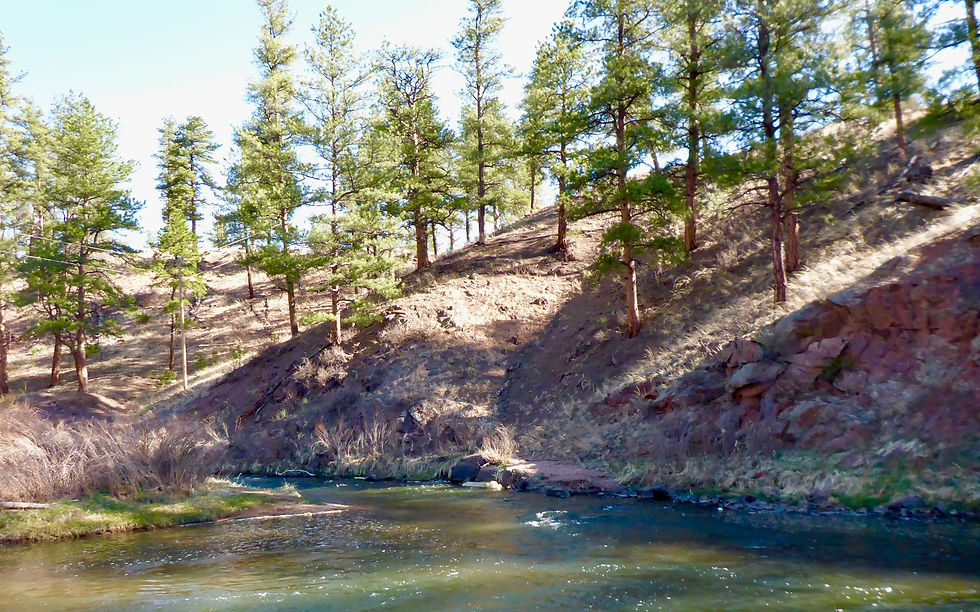
A beautiful morning.
That’s what greeted us as we pulled into the Bridge Crossing parking area. It was a brisk 44 degrees but there was bright sun light to warm us and just a slight breeze. What a difference from last week.
Solitude, beautiful scenery, and hungry trout.
That’s what you’ll find at the Bridge Crossing Run on the upstream side of the bridge. No wonder I’m drawn to it. It’s a little gem that I like to stop at times on my way to Deckers. I think Brian can take it or leave it, but I have a feeling that it’s growing on him.
The back side of the island in the Bridge Crossing Run.
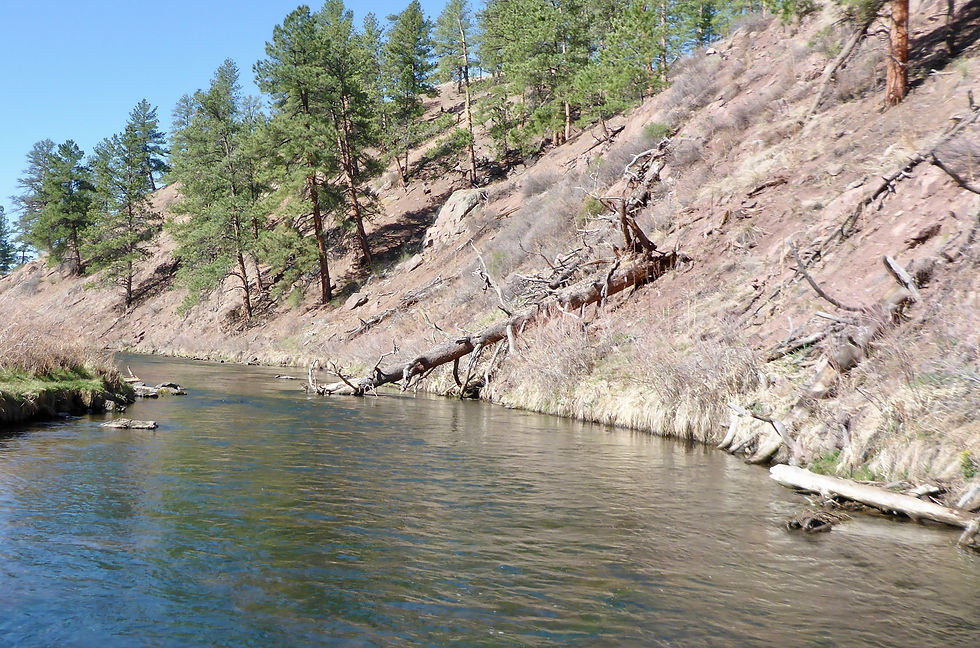
The bridge provides a nice observation deck for locating fish. When they’re in the run on the upstream side of the bridge you can spot them. Then it’s just a matter of hiking down to where they are and casting your flies to them.
Simple right?
Well, there are a ton of other variables that can – and will – make it very challenging. So,no – it’s far from simple, but sometimes everything seems to fall into place and you can get into a bunch of both rainbows and brownies. Nice size ones too.
When that happens and you throw in the scenery and the solitude – especially on the back side of the run – it’s a recipe for a great fly-fishing experience.
This time when we peered into the river from the bridge, we didn’t see any fish. I normally check the river before committing to the run. If I spot fish then it’s a go. If not, it’s a toss-up. But this time I already made up my mind that I wanted to stop there and Brian was game. So despite not seeing any fish we hiked down to the river.
A beauty - with it's pinkish stripe.
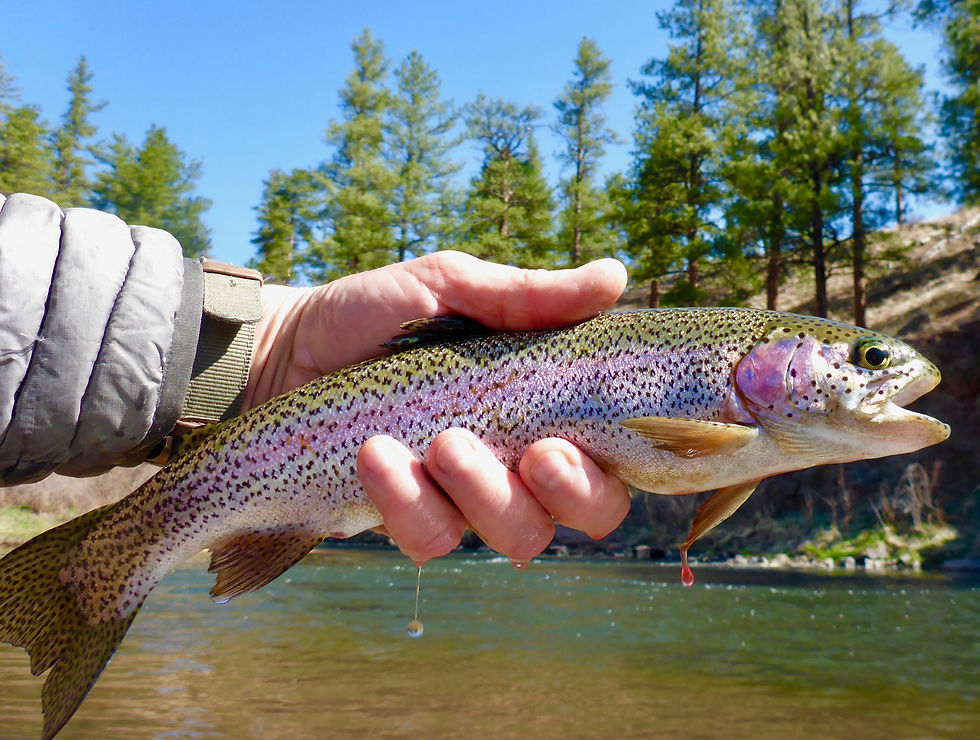
We walked upstream to the bottom of the island where Brian set up and began to cover the pool below it. It’s a fishy spot and we usually will get some fish in it. I moved to the other side of the pool and set up just below the island but soon gave up on it and moved to the other side of the island.
There is a spoke of the river that runs around the island river-left. It’s very similar to a creek – not too wide with pockets, pools and troughs. The water flows a little slower on this spoke and the fish are very spooky. If they are in there you can see them and you have to sneak up on them. Even getting your flies to them without spooking them is challenging. I’ve only caught a few fish in that little run, but I’m drawn to it intent on fooling those wary trout.
Despite the fact that there were no fish in sight along that side of the island, I covered it from the bottom of the island to the top hoping that a brownie would appear out of nowhere and take one of my flies. But that didn’t happen.
Brian got this one - also with a pinkish stripe. He got this one in the Bridge Crossing Run as I did.

Brian Kenney.
When I got to the top of the island I saw Brian ahead of me fishing the river before it hits the island. I usually don’t fish this far upstream and I found that it has some really nice holding areas. Riffles, pockets, deep troughs, and pools.
So far neither of had seen a fish. As I was moving upstream I ran into a small pool with a big, submerged boulder at the top of it. I began to cast my flies on the near side of the boulder and let them float into the soft water behind – thinking to myself there had to be a fish in it.
On one of my drifts my indicator began to move slower than the foam that was floating in the seam and I instinctively set the hook. BAM – fish on! But only momentarily. Fish usually face upstream looking for insects to eat. When you get a hit you either set your hook straight up or in a downsteam motion. I’ve been accustomed to setting with a downstream motion – and it works almost all the time.
Almost.
This time the fish chased my flies – swimming downstream after them – and when I set the hook I actually pulled the fly out of his mouth! Augh!
Brian got this one in the pool below the island in the Bridge Crossing Run.

Brian Kenney.
As I was covering the small pool I saw Brian hook up and net a nice rainbow. He was in a larger pool upstream from me and got the rainbow to take a #20 Black RS-2.
After covering that part of the river we decided to head back downstream toward the pool. We split up at the island – me covering the spoke one more time. I couldn’t resist! Brian covered the main leg of the river and we met back up at the end of the island. For some reason there wasn’t as many fish in the run as we normally find and we decided to head to the car.
As we were walking past the pool below the island I said I wanted to give it one more try. I was casting in the foam line that is formed where the legs of the river meet as they flow around the island. Brian was downstream of me covering the tailout of the pool.
After a few drifts my indicator paused a bit and I set the hook. BAM – fish on! He proceeded to swim right at me which is not a good thing. My line was going slack and I had to strip it back as fast as I could to get it taunt. While I was doing this Brian hooked up a fish. Wow – after a kinda slow morning we doubled up!
Brian extracted these baetis and a midge out of one of the rainbows he got in the afternoon.

I soon netted a 16” pinkish colored rainbow – he took my #22 Black Beauty. Brian had his fish in the net soon after a 12” rainbow that took his Black RS-2.
We were both thinking – jeez, maybe we should stay, but after releasing our rainbows there was no further action and we decided to head into Deckers. It was about 11a and the BWOs would soon be hatching. Our plan was to head to Fishermen’s Run hoping that we’d find some rainbows and browns rising to take adults off the surface.
As we approached the run we spotted several rainbows doing just that. We could also see them hitting emerging flies just below the surface. Perfect!
A Dry/Dropper setup would be ideal. Maybe entice a trout to take the Dry on the surface or the Dropper just below it. I set my nymphing rig streamside and waded into the river – dry fly rod in hand. I entered the river quite a distance upstream from where the fish were rising so I wouldn’t spook them. Once in position I tied a #22 Grey Sparkle Dun on as my Dropper below my #18 Parachute BWO.
Brian got this brownie in Fishermen's Run.

Brian Kenney.
We found the fish to be very picky. They were selectively feeding on something but what was it? After a bit it seemed that most of the fish were eating flies off the surface and I changed out my dropper for a dry fly. Brian meanwhile was fishing with his nymphing rig hoping to get one of the fish eating the emerging insects.
We still weren’t certain what was hatching. We saw some BWO in the air but not on the water. Was it possible that there was a midge hatch occurring simultaneously with the BWOs? I didn’t know and tried some midge imitations along with my Parachute BWO. After tying on a Griffith’s Gnat – which imitates a cluster of midges - I had a couple of hits, very quick strikes that were almost impossible to set on.
An understanding of entomology is important to the fly fisher but the advice from the experts is “just keep it simple. Don’t overcomplicate it”. If midges are hatching – tie on midges. If BWO are hatching – tie on BWOs….etc. Size, shape, and color in regards to your fly selection that is what’s important – in priority order.
One of the rainbows I got out of Fishermen's Run.
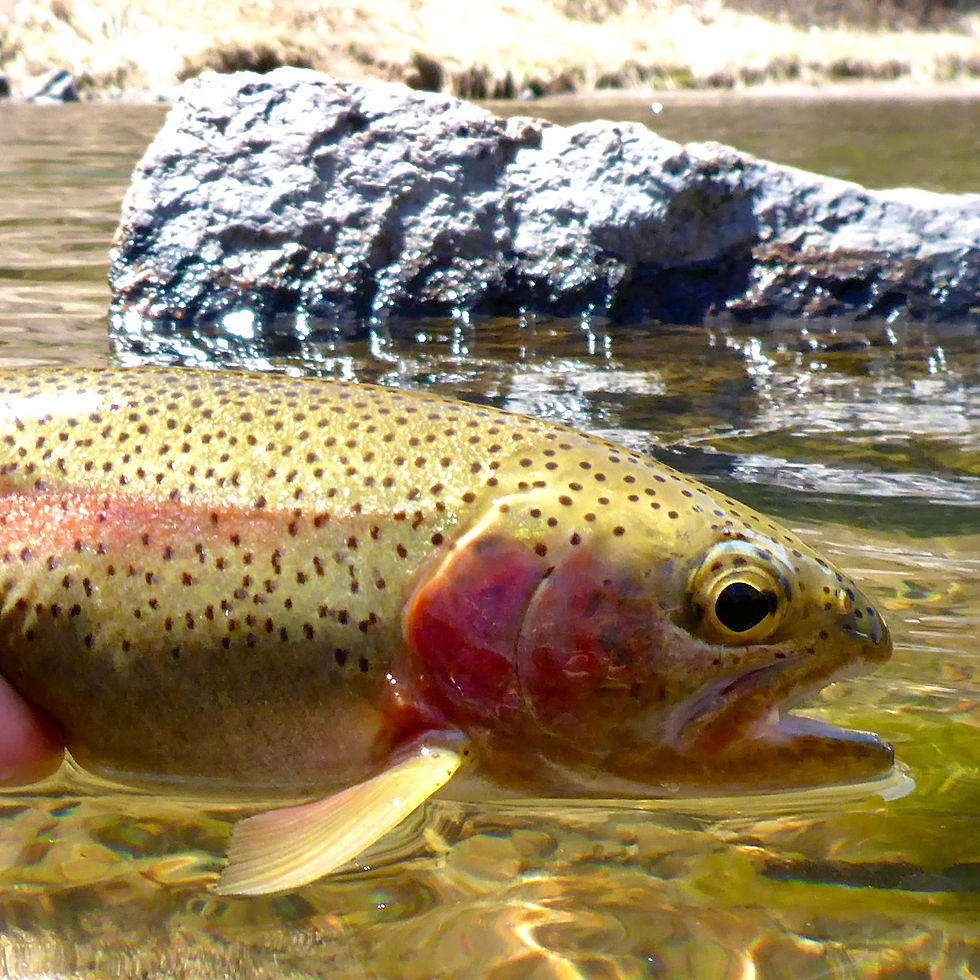
It got to lunch time and we sat streamside eating watching the fish rise. Brian’s feet were partially in the water and he had a bunch of baetis clinging to his boots. Eventually I got out my aquarium net and caught a few of the flies that were floating by on the surface. They were black BWOs.
OK – so now we know what they are we should be able to imitate them. Any time BWOs are hatching my go-to set up is a Parachute BWO or Parachute Adams followed by a Sparkle Dun. The Sparkle Dun works like magic and it’s usually fish on every third or fourth cast.
But not today!
Brian and I got into a discussion about BWOs and it got me thinking so I did a little research after we got back. BWOs – AKA – baetis are one of many subspecies of Mayflies. There are at least 150 subspecies of them in the world – mostly in the North America and Europe - and 20 subspecies of them in Colorado. It just so happens that all 20 of the subspecies reside in and along the South Platte River.
A beautiful - female taken out of Fishermen's Run.
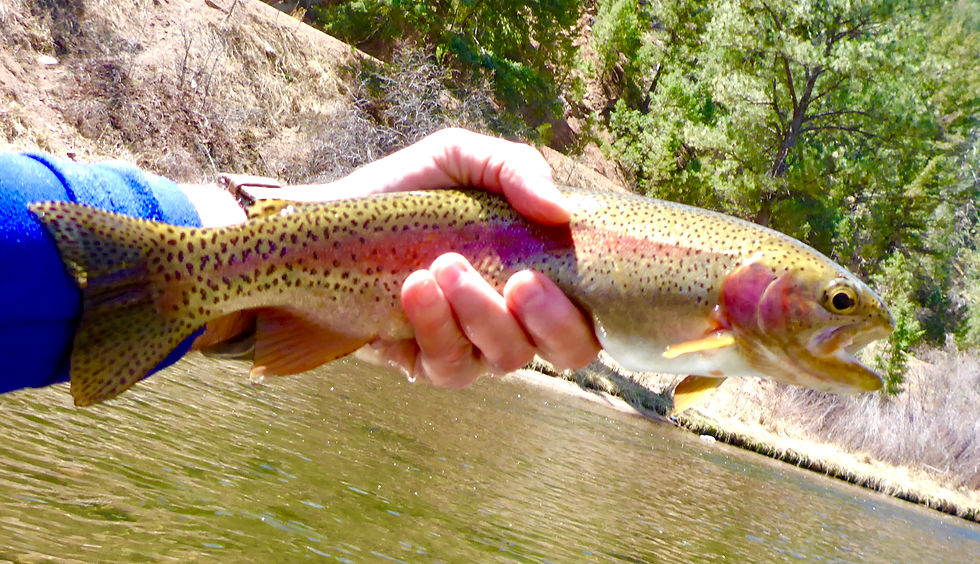
I found that interesting and I didn’t realize there were so many subspecies of BWOs. I do know that in the spring the BWOs are comparatively larger and in the fall they are smaller. Now that I know about the many subspecies, I’m still going to stick to what I’ve been doing. I’ve got BWO imitations in their nymphal/pupae, emerger, and adult stages – all in various colors. That should do it.
There is one fly that I’ve been anxious to try. It’s a Klinkhammer – developed by Hans van Klinken. It’s a dry fly pattern that imitates an emerger that is stuck in its shuck. It’s one of the fifty flies that are mentioned in the book “The History of Fly Fishing in Fifty Flies”. Now I had the opportunity to try it out.
It was tied on as my lead fly and after several drifts I had one that was spot on. I was thinking to myself “this is a beautiful drift. Somethings got to hit it”. And then BAM – finally!!
Fish on - oh yeah baby!
And it was a nice one.
A brownie fighting like all get out to free himself. Brian and I were pretty close together. He was just downstream of me and that’s where the brownie was heading. My thought was “don’t let the fish get tangled up with Brian”. Then the damn brownie shot out and almost ran into him. I was able to get him out in front of Brian and now had him across from me – only a few feet in front of Brian.
One of Brian's brownies.
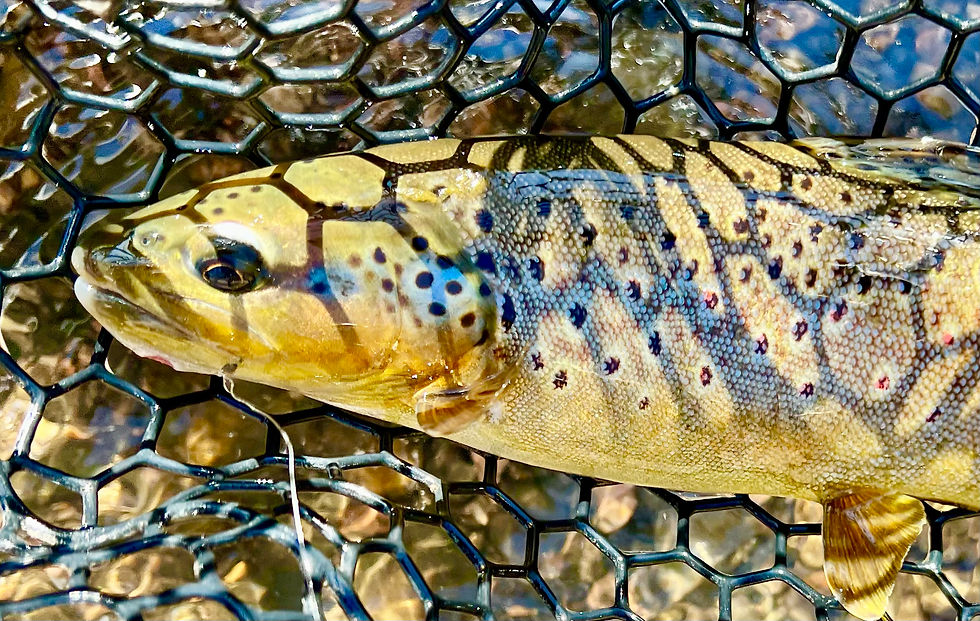
Brian Kenney.
He was tiring out as I led him to my net. But as soon as he saw it he made another run – streaming line out of my reel. This time he went past Brian and then downstream of him. Just what I didn’t want. I tried to guide him back upstream and away from Brian and he was pulling hard to swim downstream. Something had to give – and it did.
My line snapped.
After all that work I wanted that bad boy in my net and I was a bit pissed that he got away. To make matters worse – he took my Klinkhammer with him!
Was Klinkhammer the perfect imitation of what was hatching? Is that why the brownie took it? I don’t think so. I think it was close enough and the spot-on drift did the trick.
Brian had changed his rig to a Dry/Dropper. He was experiencing the same thing as me. Drift after drift with no hits. After several changes to his flies – he casted a green caddis larva as his dropper into the pool where the trout were feeding. BAM! That did the trick and he soon netted a nice 16” or so rainbow.
Beautiful coloration on this rainbow.
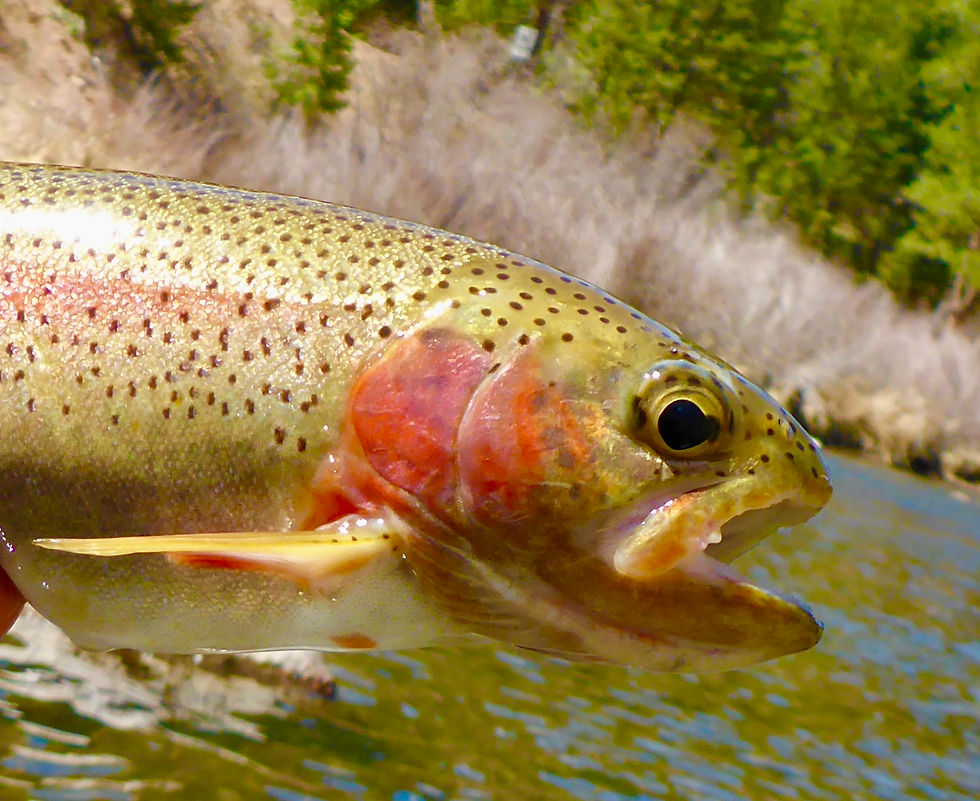
We kept casting into the pool and after a bit Brian wanted to head upstream to Ray’s Run. I was intent on getting one of these fish to hit and said I was going to stay a while longer. Just before he left a 17” rainbow sipped my BWO Emerger. I watched him come up – take the fly – and go back under. I then set hard and had him hooked up.
He was a game fighter too, taking me all through the run and making several runs. There was no way I was going to let this one break off – at least I was doing all I could to avoid it. Then I had his head up out of the water. He was spent and I led him into my waiting net.
After I released the fish I was now ready to head up to Ray’s Run. For some reason, Brian was still in Fishermen’s Run – he never left. So I was first to reach Ray’s and as soon as I got there I spotted a handful of nice rainbows sipping adult flies off the surface just like they were in Fishermen’s Run.
A rainbow Brian released back into Ray's Run.
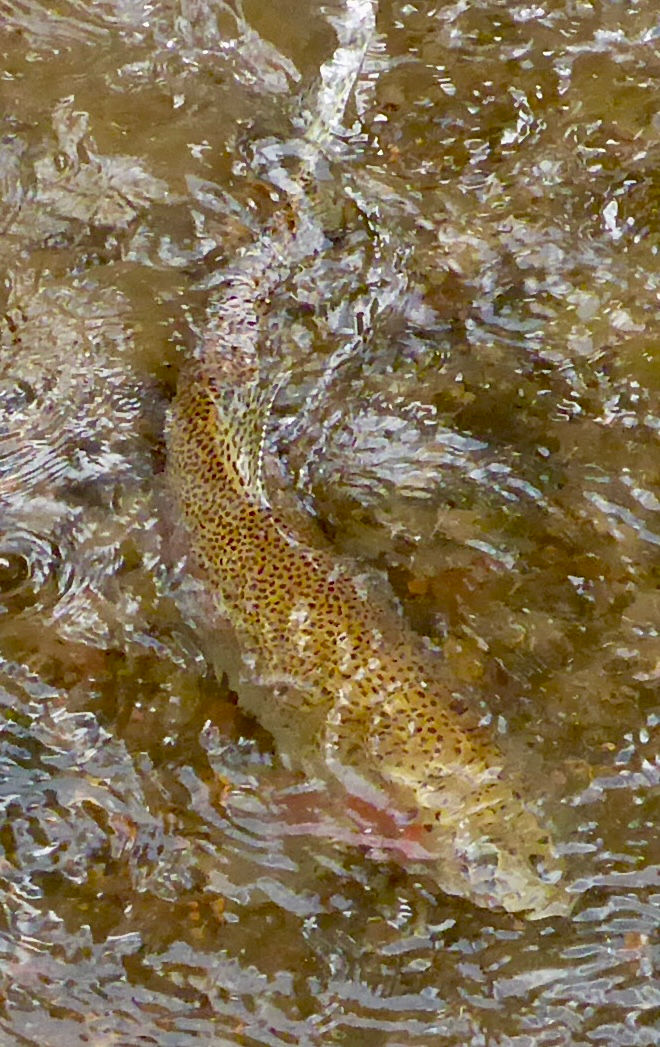
The water in Ray’s was shallower and running slower making it very difficult to fool these guys. As I was casting to them, Brian moved past me and found some fish in a trough along the other bank – river-left. In that spot there are some pockets, small pools, and a couple of long deep troughs.
Brian was standing near the bank and casting back into one of the troughs where he could see a few rainbows feeding in it. He was able to entice one of them to take his #20 Flashback Pheasant Tail. He called out and I watched as he fought the rainbow and brought him to net.
Meanwhile I moved into one of the troughs that was closer to me – in the middle of the river. I watched as my flies drift into the trough as a nice rainbow came up and inspected my Parachute BWO. It didn’t pass the sniff test though and he broke off before taking it.
Brian with a beauty of a 17" rainbow.
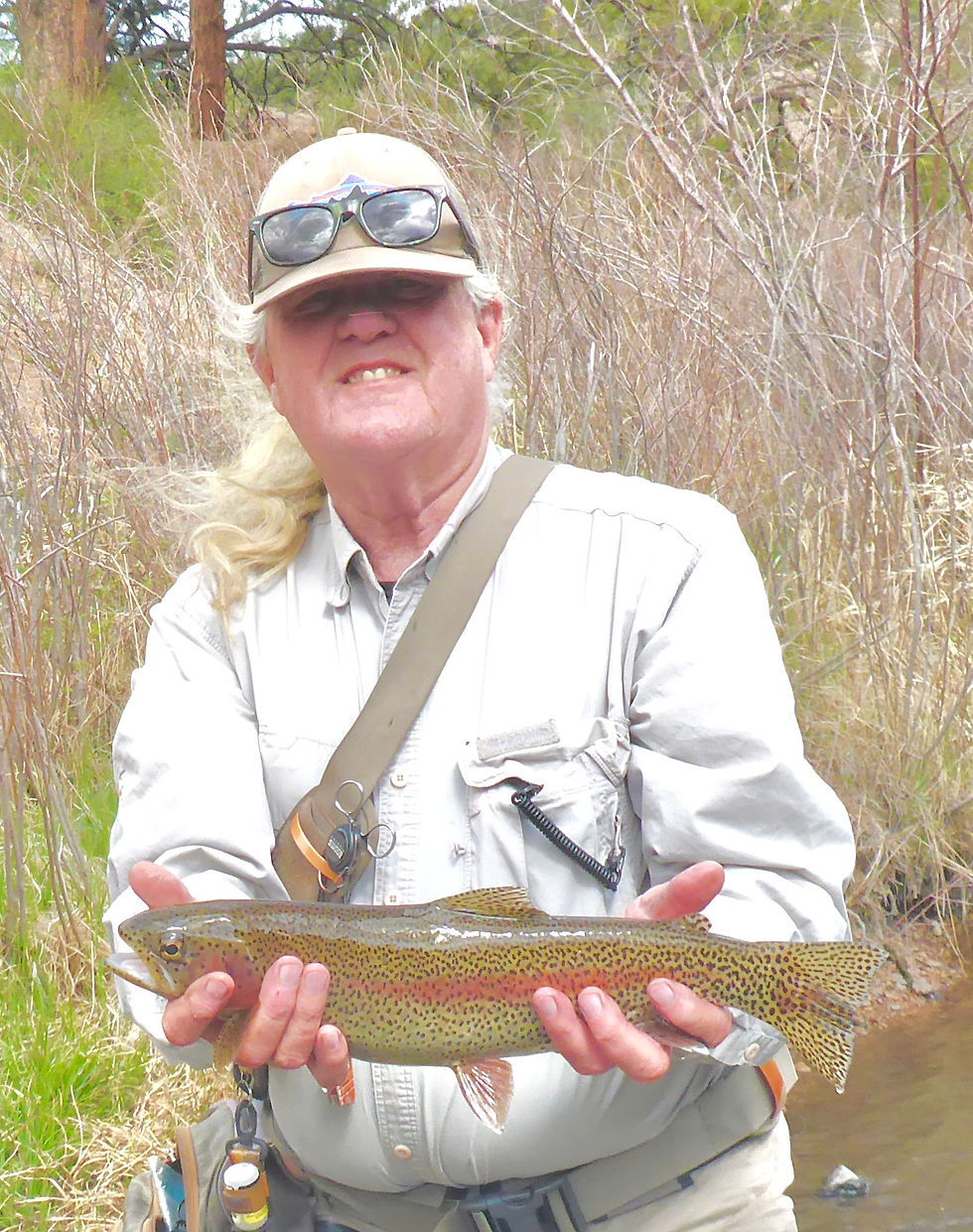
It was getting toward time to go and Brian was now casting into one of the small pools where he could see some rainbows feeding. He still had on his #20 Pheasant Tail and he got one of them to take it. The fish came up a few times and I could see it was a nice one and he gave Brian all he could handle.
But Brian got him in the net and it was a beauty – a healthy, fat, 17” rainbow.
Brian chose wisely.
The Pheasant Tail did the trick and it was a good way to end the day.
Comments